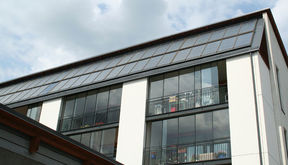Solar heating could cover more than 80% of domestic heating requirements in Nordic countries

According to researchers at Aalto University, by using suitable systems, more than 80% of heating energy for Finnish households could be produced using solar energy. As the price of heating energy obtained from solar heating systems needed to be competitive with the currently used heating alternatives, calculations made by researchers showed that renewable energy could be used to cover 53–81% of annual domestic heating energy consumption depending on the technical implementation method.
'In principle, this result is also valid for Sweden, Norway and other locations at the same latitudes. Of course, local conditions have some effect on this,' says Hassam ur Rehman, a doctoral candidate at Aalto University.
The researchers calculated the amount of solar heat obtained for heating the households when excess energy was stored for use during cold periods. The researchers calculated the amount of heat obtained for practical use when energy for heating households was accumulated using solar heating and the accumulated heat was stored for use during cold periods. In their calculations, the researchers studied the use of both above-ground water storage tanks for short-term heat storage and a borehole storage suited for seasonal storage. The results depended on the method of how the heat pumps and the water storage tanks and the borehole storage for storing heat were used together.
The heating of buildings is one of the largest sources of carbon dioxide emissions in Europe. In the EU, this heating takes up 40% of all energy consumption.
'In Finland, more than 80% of the energy consumption in households goes to heating buildings and water, and this is on the increase. Solar energy offers economically sensible solutions for the collection of energy for this purpose, and for the reduction of carbon dioxide emissions, especially in southern Finland where the majority of the population lives,' says Kai Sirén, Professor at Aalto University.
The decrease in prices has already made solar energy a viable alternative in the energy market in the Nordic countries as well. For example, in Denmark, the use of solar energy in district heat production has rapidly increased.
Sirén feels that it is important to continue the research work, which will require measurement results on a system built and implemented in Finland.
'We are talking about a computational result which includes factors of uncertainty even if the initial values have been carefully selected and the simulations conducted meticulously,' Sirén reminds us.
Additional information:
Kai Sirén, Professor School of Engineering, Aalto University Tel. +358 40 5741871 [email protected]
Article: Hassam ur Rehman, Janne Hirvonen, Kai Sirén: A long-term performance analysis of three different configurations for community-sized solar heating systems in high latitudes. Renewable Energy 113 (2017) 479-493.
https://doi.org/10.1016/j.renene.2017.06.017
- Published:
- Updated:
Read more news

Get to know us: Associate Professor Maria Sammalkorpi
Sammalkorpi received her doctorate from Helsinki University of Technology 2004. After her defence, she has worked as a researcher at the Universities of Princeton, Yale and Aalto.
Aalto computer scientists in ICML 2024
Computer scientists in ICML 2024
In low-hierarchy organisations, even key policy issues are discussed in Slack
In a recent study, Aalto University alumn Lauri Pietinalho, a visiting scholar at New York University's Stern School of Business, and Frank Martela, an assistant professor at Aalto University, investigated how low-hierarchy organisations deal with shared policies in confrontational situations and how authority functions within them.